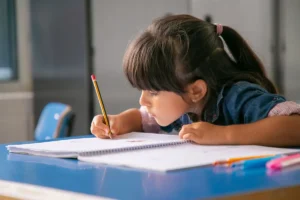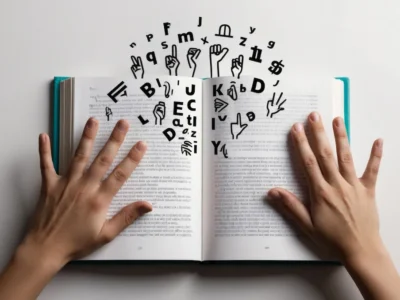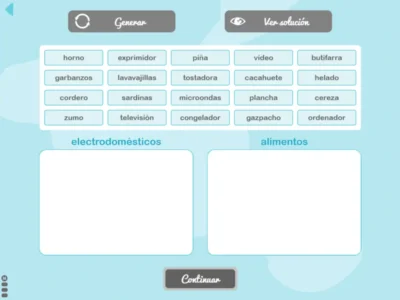Covadonga García San Nicolás Cantero, clinical psychologist and neuropsychologist, explains in this article all the necessary information to correctly understand what dysgraphia consists of.
Dysgraphia is a specific learning disorder related to a difficulty in writing that affects the person’s academic performance and everyday life.
What is dysgraphia
There are differences among authors when defining what dysgraphia is; however, all agree on the importance of emphasizing that the existing difficulty is related to handwriting or graphomotor skills, not to orthographic and/or syntactic rules. Thus, these children do not have problems in planning body movements in general, but they do find coordinating the hand or arm when writing in an orderly way challenging.
The DSM-5 specifies that these complications are not due to inadequate instruction, nor to the presence of neurological and/or mental disorders, nor to uncorrected hearing or visual disorders, psychosocial difficulties, or intellectual disabilities.
What causes dysgraphia
According to its origin, dysgraphia can be acquired or developmental:
- Acquired: When the person initially has no difficulties in the ability to write but, as a result of a brain injury, loses their writing ability.
- Developmental: When early stimulation of the child has not been sufficient for learning to write.
In dysgraphia there are different skills or capacities that may be affected. Some of these capacities are the following:
- Fine motor skills: Some capacities affected in dysgraphia relate to motor planning, visuo-motor or eye-hand coordination, and graphomotor skills.
- Executive functions: Related to the capacity to retain and manipulate information (working memory) which can affect organization and planning when writing. Processes related to drafting, reviewing and editing written material may also be affected.
- Psycholinguistic skills: Allographic-type alterations, difficulties in writing fluency or in phoneme-grapheme conversion. Difficulties may appear in phonology, syntax, morphology, pragmatics and semantics of language.
- Spatio-temporal skills: It is common to find an afferent dysgraphia, that is, an inadequate use of the page space. The person tends to write upward or downward, without properly controlling the spacing of letters and words and the sheet in general.
- Laterality and body schema: In cases where laterality is poorly defined, such as in ambidexterity, this disorder is commonly found. The body schema is fundamental since it can affect the way the writing tool is held and the body posture when writing.
Types of dysgraphia
As happens with definitions of this learning disorder, there are different classifications of the types of dysgraphia. In general, a distinction is made between:
- Motor dysgraphia: When the child has no difficulties mentally representing the symbols but does show problems reproducing them in writing due to motor difficulties.
- Specific dysgraphia: When the problem is related to the perception of shapes to reproduce symbols, as well as difficulties in spatio-temporal orientation and writing rhythm. In this type of dysgraphia there are no motor problems.
According to the affected processing route:
- Phonological: When there are alterations in phoneme-grapheme conversion due to difficulty integrating the shape of words. It is common to find difficulties when writing pseudowords.
- Surface: When difficulties are related to the visual route, having to resort to the phonological route. That is, these people do not have the construction of words integrated, which can lead to errors in the graphemes of multigraphic and homophone words.
- Mixed or deep: When dysgraphia affects both processing routes.
Treatment of dysgraphia
To treat dysgraphia it is necessary to know the child’s signs or symptoms. It should be noted that each person is unique, so each case will present different difficulties and intervention must be adapted specifically and individually by a professional.

Subscribe
to our
Newsletter
Symptoms and signs of dysgraphia
The signs and symptoms of dysgraphia are usually identified during the learning-to-write stage, that is, when the child is learning to write. However, it may also happen that these problems are not identified until academic demands increase, making the difficulties more evident.
Below are some warning signs of dysgraphia:
- Inappropriate body posture and paper position when writing.
- Problems making the pincer grip when holding the pencil.
- Excessive motor rigidity or excessive laxity when writing, that is, there is no control over pencil pressure, sometimes piercing the paper.
- Discomfort in the hand or arm.
- Irregular strokes that vary.
- Different sizes of letters and words.
- Slowness when writing.
- Problems forming connected (cursive) letters.
- Illegible handwriting.
- Problems ordering letters within words, leaving some incomplete.
- Margins of the paper are not respected, with irregular spacing across the page and between letters and words.
- Lack of motivation and frustration when writing.
Support for children with dysgraphia
To help a child with dysgraphia the most important thing is early detection of these difficulties. As mentioned earlier, these difficulties can be observed during the period of learning to read and write, although sometimes the existing problems are not detected until academic demands increase.
For this reason it is important that both the school and the family environment pay attention to the child’s learning process. In this way an evaluation and an intervention adjusted to the person can be carried out, trying to prevent the child’s difficulty from worsening, as well as trying to mitigate the academic, socioemotional, and self-esteem consequences that may arise as a result of dysgraphia.
Below are some general recommendations that can be taken into account in the case of dysgraphia in a minor, emphasizing the importance of an individualized process:
- Understand and validate what the person feels when writing or when thinking about writing.
- Provide accommodations at school.
- Strengthen fine motor skills and coordination.
- Offer tools that compensate for the difficulties.
- Promote an appropriate body and paper posture when writing.
- Use tools that facilitate a correct pencil grip.
- Teach relaxation techniques.
- Work on visuo-motor, psycholinguistic, spatio-temporal skills and body schema awareness.
- Address the frustration or pressure the person may feel regarding writing.
- Handwriting re-education.
Dysgraphia and dysorthography
Dysgraphia and dysorthography are two concepts that are commonly confused, so it is useful to know how to identify them in order to distinguish and address them correctly.
Dysorthography is related to difficulties that affect spelling rules when writing a word, without graphomotor or reading problems. In dysgraphia it is common to find spelling difficulties.
Dysgraphia and dyslexia
The dyslexia can also bring difficulties in expressing oneself in writing. However, it is a specific learning disorder that refers to difficulties in reading and writing that can also involve problems understanding what is read, difficulties accessing the lexicon, spatio-temporal errors and in distinguishing left from right, etc.
Below are general examples of the three disorders mentioned. It should be noted that, as with dysgraphia, these difficulties manifest with different symptomatology depending on the child. Due to the generality of these examples, the intention is to identify the difference between the disorders. However, an exhaustive evaluation by a professional would be necessary to confirm the diagnosis:
- Example of dysgraphia: Raquel is 7 years old and has difficulties writing in an organized way on the paper, being unable to write straight even if the paper has lines or squares, and she does not maintain adequate pressure when holding the pencil, gripping it too hard and sometimes piercing the paper. Her letters are irregular and illegible, and she has poor handwriting. Raquel has a normal IQ and no comprehension problems.
- Example of dysorthography: Ana is 8 years old and has difficulties recognizing and applying orthographic rules, making frequent errors even in the simplest words. Ana has normal language development and a normal IQ, and she has no complications in reading or writing.
- Example of dyslexia: Daniel is 9 years old and has difficulties understanding what he reads. Furthermore, when he reads, he does so slowly, making errors. Sometimes he omits and inverts letters. Daniel has normal language development and a normal IQ, and he has no writing complications.
Conclusions
Dysgraphia is a specific learning disorder that affects writing and arises from different interacting factors, highlighting graphomotor skills. Early detection of these problems is essential in order to work on them. Furthermore, dysgraphia is often accompanied by other difficulties, so it is important to distinguish them in order to make a correct differential diagnosis and an appropriate, tailored intervention for each case.
Bibliografía
- American Psychiatric Association. (2013). Diagnostic and statistical manual of mental disorders (5th ed.). American Psychiatric Publishing.
- Duque, M. E. Á., Vega, O., y Alvarez, F. V. (2003). Aproximación neurocognitiva de las alteraciones de la lecto-escritura como base de los programas de recuperación en pacientes con daño cerebral. Revista española de neuropsicología, 5(3), 227-249.
- Gil, I. A. (2019). Dificultades específicas de aprendizaje: la disgrafía. LA COMPETENCIA LINGÜÍSTICA EN LA COMUNICACIÓN: visiones multidisciplinares, 129.
- González-Agulló, L., Rodríguez-Sánchez, M., y Lapinet-Azuaga, J. L. (2021). Disgrafía en los procesos educativos. Revista Portal de la Ciencia, 2(1), 1-14.
- González, L., Rodríguez, M., y Lapinet, J. L. (2022). Disgrafía en los procesos educativos. Portal De La Ciencia, 2(1), 1–14. https://doi.org/10.51247/pdlc.v2i1.295
- Granda, L. M. C., González, E., Arias, G. L., Suing, J., Calvopiña, R. E., y Silva, S. M. (2022). La reeducación grafomotora y su incidencia en problemas con disgrafía en los niños y niñas de segundo año de educación básica. Ciencia Latina Revista Científica Multidisciplinar, 6(4), 6142-6165. https://doi.org/10.37811/cl_rcm.v6i4.3533
- López, M. (2016). Disgrafía y disortografía: diagnóstico y tratamiento en alumnos de 2º de EP (TFG) [Trabajo de fin de grado, Universidad de Cantabria]. https://repositorio.unican.es/xmlui/bitstream/handle/10902/8728/LopezPecesMirian.pdf?s.
- Rivas-Torres, R. M., y López-Gómez, S. (2017). La reeducación de las disgrafías: Perspectives neuropsicológica y psicolingüística. Pensamiento psicológico, 15(1), 73-86.
- Veintimilla, A. L., y Barba, P. A. (2023). La disgrafía y sus impactos en el aprendizaje de los niños. Revista Científica Arbitrada Multidisciplinaria PENTACIENCIAS, 5(6), 467–475. https://doi.org/10.59169/pentaciencias.v5i6.869
If you liked this article about dysgraphia, you will likely be interested in these NeuronUP articles:
“This article has been translated. Link to the original article in Spanish:”
Comprendiendo la disgrafía








Leave a Reply